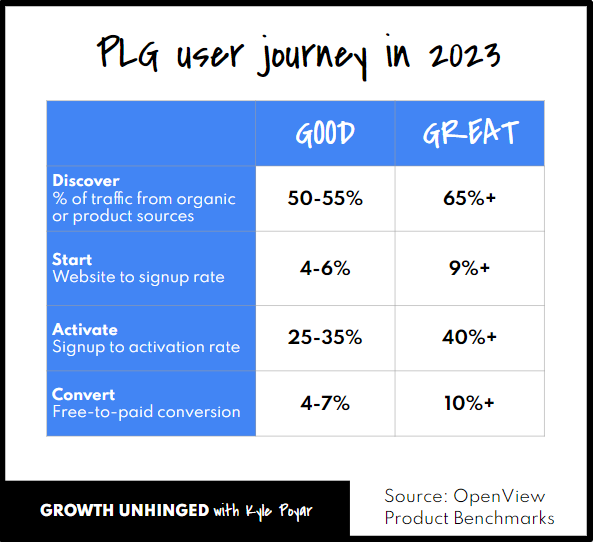Your guide to SaaS product metrics
🔥 Exploring new data from 1,000+ products
👋 Hi, it’s Kyle. Welcome to another edition of Growth Unhinged, my newsletter that explores the unexpected behind the fastest-growing startups.
Our team at OpenView released its first Product Benchmarks report in 2020 to help founders and product folks make better decisions. That first year we had a modest dataset of 150 products and product-led growth (PLG) wasn’t yet a widely used term, let alone a way that publicly traded SaaS giants described their strategy.
Fast forward to 2023. The interest in products as a growth driver is far greater than only a few years back. In partnership with Pendo, we’ve surveyed more than 1,000 products, allowing us to slice the data in novel ways.
You can check out the full report at this link. In today’s newsletter, I’ll unpack the five insights that stood out to me — and what to do about them.
How do you compare? Benchmarks across the PLG user journey
The hardest part of PLG might actually be… marketing?!
Forget about Threads. What’s your TikTok strategy?
Reverse trials: We’re talking about them more than we’re doing them
Activation: One of the most misunderstood metrics in SaaS
1. How do you compare? Benchmarks across the PLG user journey
As I’ve talked about before, we need a new go-to-market playbook for modern software businesses. This playbook should center around the user’s journey and treat product usage as a signal of buying intent.
With this new lens, the growth model isn’t rate-limited by SDR productivity or MQL volume. It’s defined by how many people discover the product, start using it, experience value (activate), and then decide to pay (convert).
Here’s what to expect in 2023 👇
Use this as a map to identify the biggest roadblocks holding back your growth. Keep in mind that marketing might be the most important area to focus on, and attracting higher quality users is often your best path to improve downstream product metrics.
(The benchmarks for GOOD and GREAT differ somewhat for freemium versus free trial products. You can see that data in the full report.)
2. The hardest part of PLG might actually be… marketing?!
The PLG funnel math is bleak. If an average freemium PLG product attracts 1,000 unique visitors to their website each day, they can expect:
90 free signups (9% conversion from a unique visitor)
4-5 paying customers (5% conversion from a new signup)
$10-$100 per month as an average initial spend for a new self-service customer
30-60 days to convert those free signups
⇒ You’ll make $1-$2 for each unique visitor.
Sales-led companies can afford high-touch channels for new leads like outbound prospecting (45%) and partner relationships (12%). Product-led businesses, on the other hand, need to find channel-market fit with low-cost, scalable channels for attracting new users.
Product-led marketing means making it easy for end users to discover your product when they need it, through two primary strategies:
Organic efforts like SEO, word-of-mouth, organic social
Product virality
Collectively these two sources account for more than 50% of leads for the average product-led business. Neither requires paying per click, which helps you scale efficiently.





